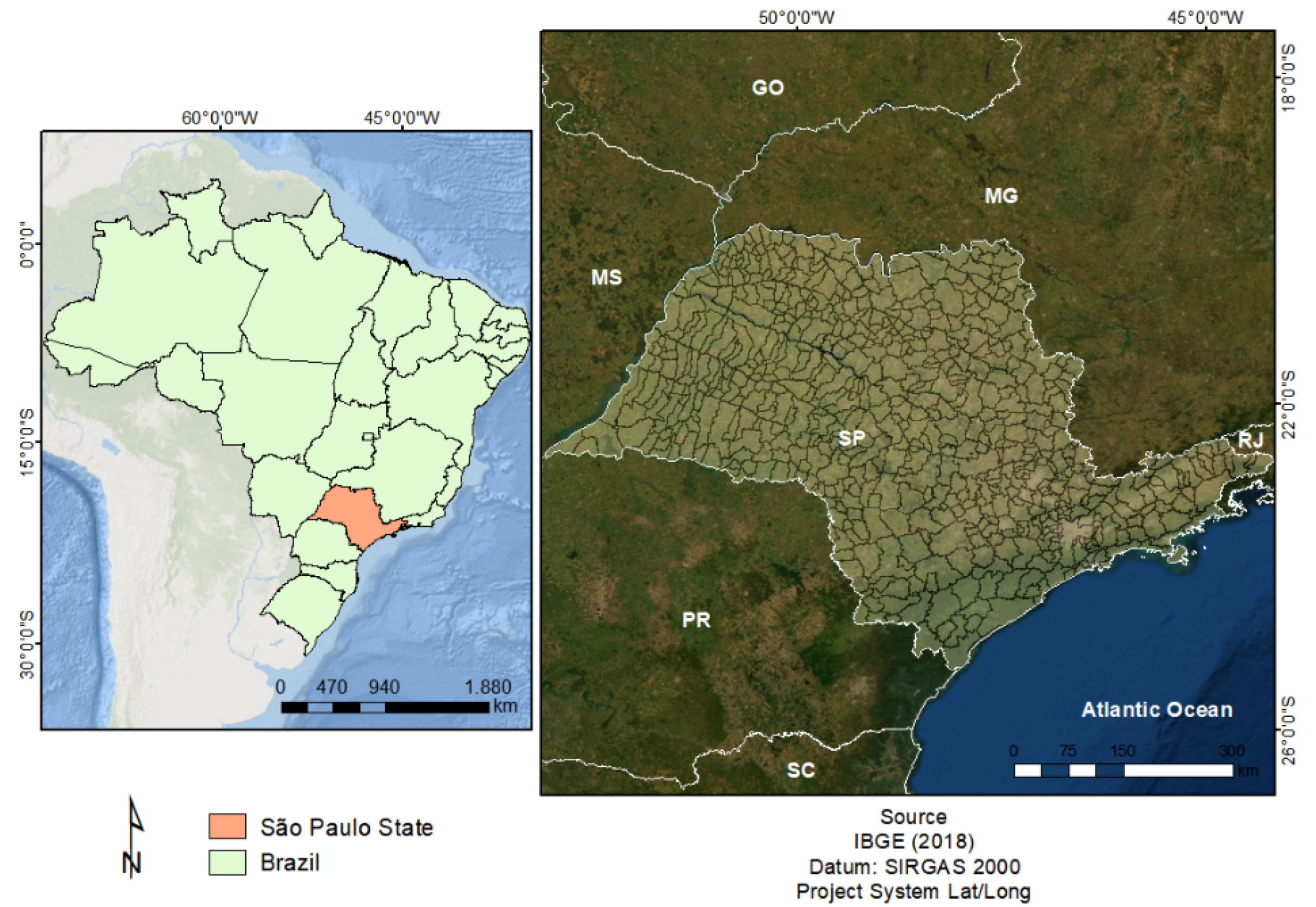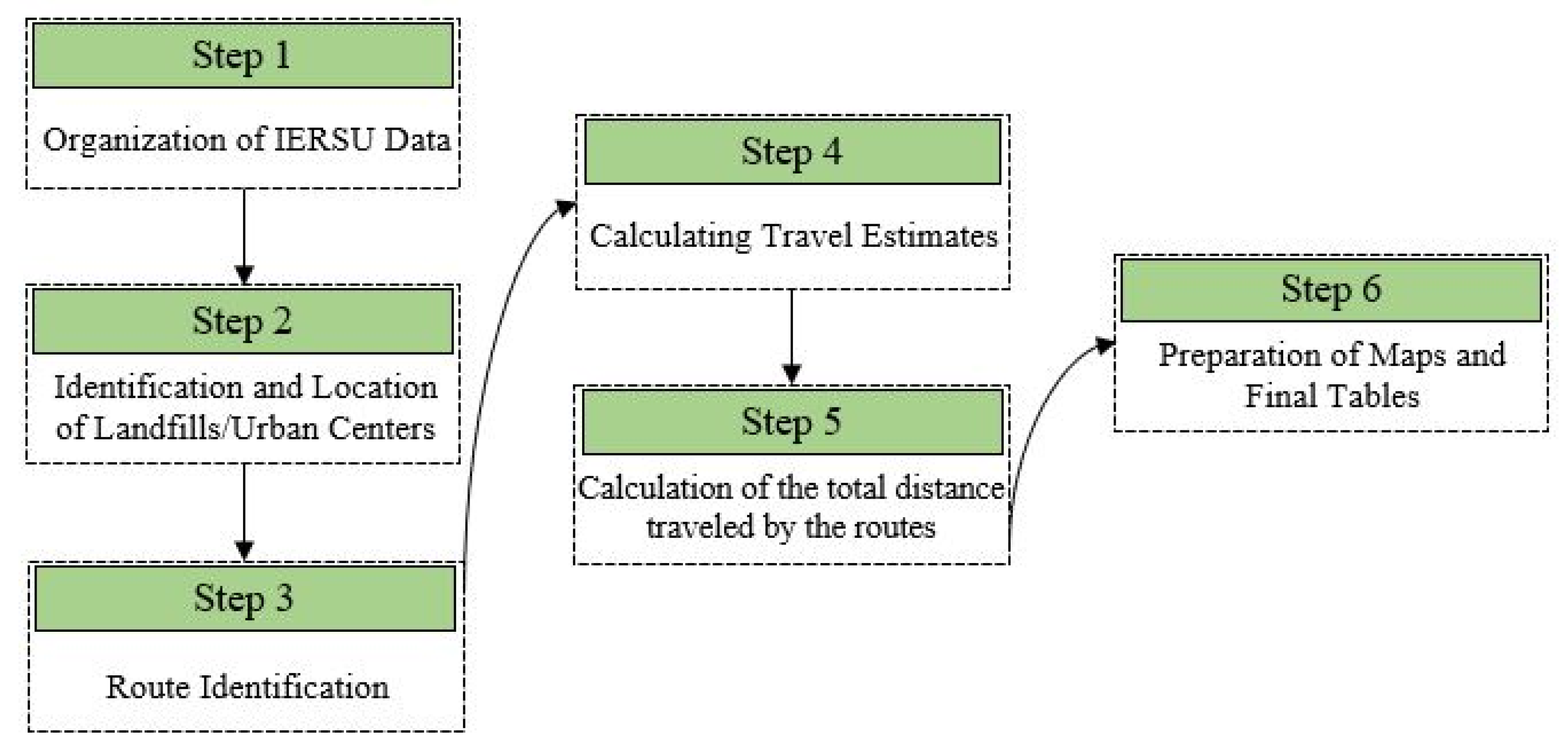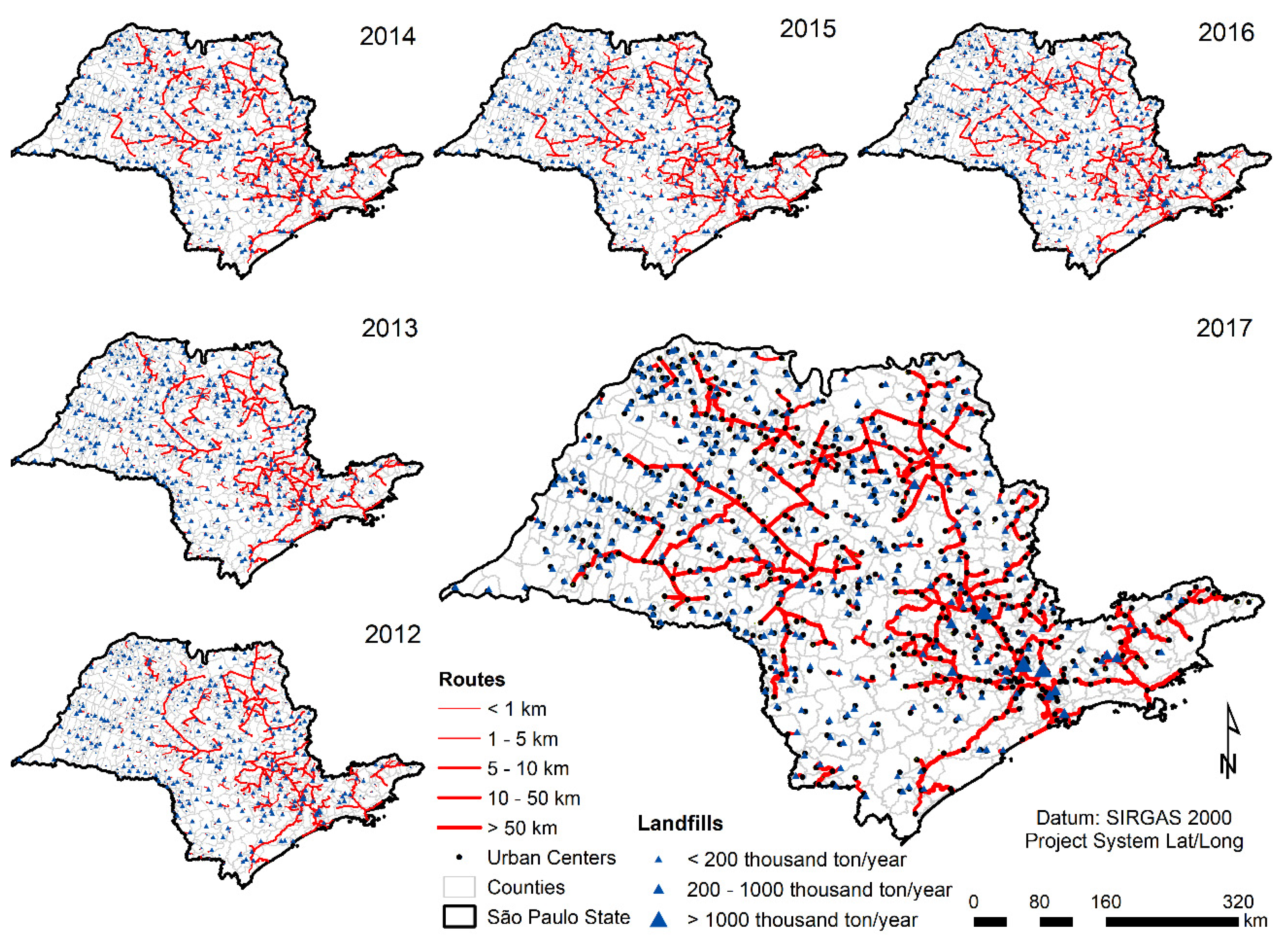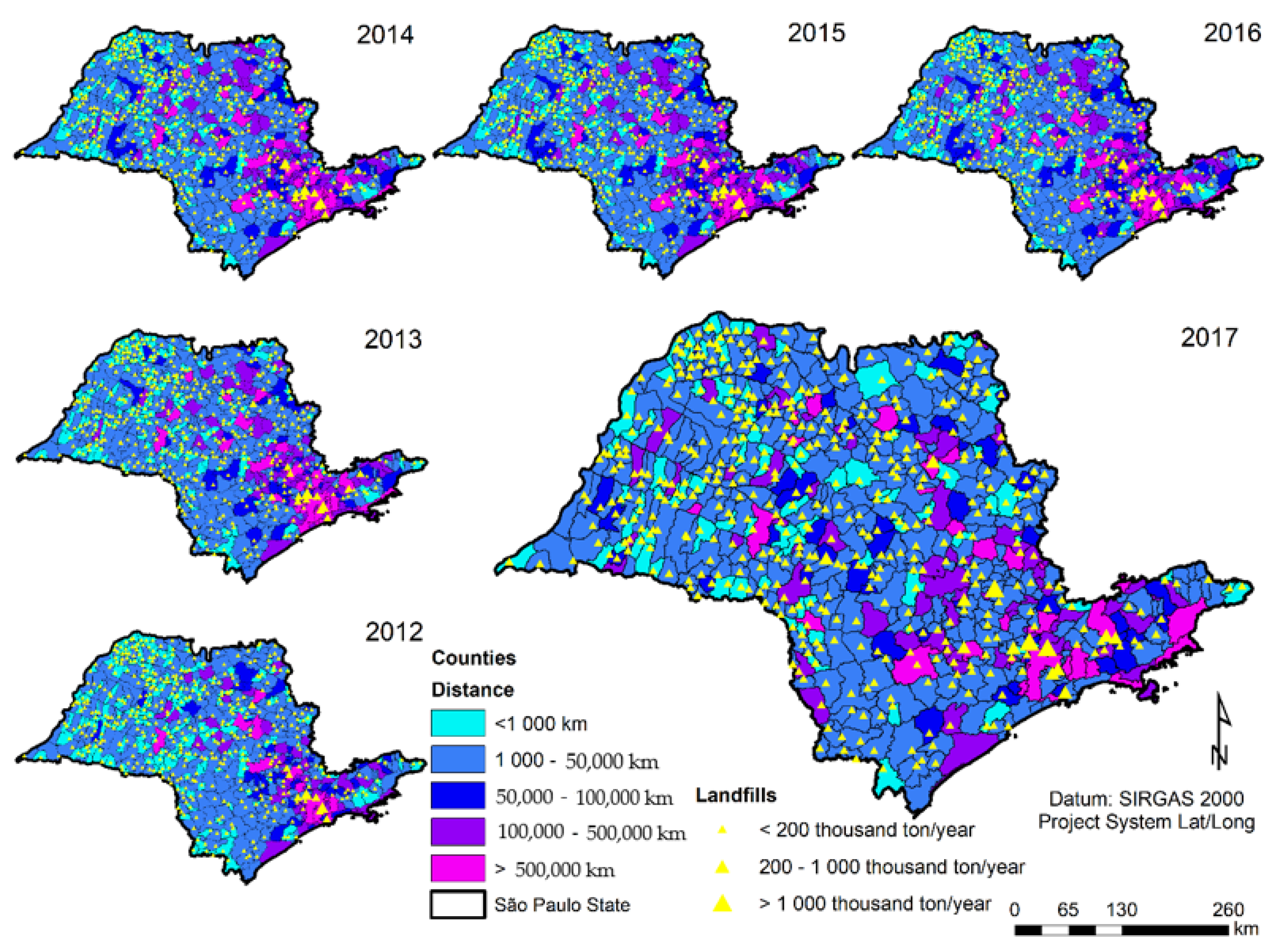Regional Distance Routes Estimation for Municipal Solid Waste Disposal, Case Study São Paulo State, Brazil
Abstract
1. Introduction
2. Materials and Methods
2.1. Study Area
2.2. Methods
3. Results and Discussion
3.1. Landfills in the São Paulo State
3.2. Routes and Distances from Urban Centers Areas and Landfills
3.3. Number of Trips
3.4. Estimates of Total Distances
4. Conclusions
Author Contributions
Funding
Acknowledgments
Conflicts of Interest
References
- Minghua, Z.; Xiumin, F.; Rovetta, A.; Qichang, H.; Vicentini, F.; Bingkai, L.; Giusti, A.; Yi, L. Municipal Solid Waste Management in Pudong New Area, China. Waste Manag. 2009, 29, 1227–1233. [Google Scholar] [CrossRef]
- Bhada-Tata, P.; Hoornweg, D. Solid Waste and Climate Change. In Can a City be Sustainable? Island Press: Washington, DC, USA, 2016; p. 450. [Google Scholar]
- ABRELPE. Panorama of Solid Waste in Brazil 2017; ABRELPE: São Paulo, Brazil, 2018. [Google Scholar]
- ABRELPE. Panorama of Solid Waste in Brazil 2012; ABRELPE: São Paulo, Brazil, 2013. [Google Scholar]
- CETESB. Inventário Estadual de Resíduos Sólidos Urbanos—2017; CETESB: São Paulo, Brazil, 2018. [Google Scholar]
- CETESB. Inventário Estadual de Resíduos Sólidos Urbanos—2013; CESTEB: São Paulo, Brazil, 2013. [Google Scholar]
- Spinola, G.M.R.; Nascimento, V.F.; Andrade, P.R.; Ometto, J.P.B. Análise Estatística Da Composição Gravimétrica Dos Resíduos Sólidos Urbanos Com o Índice de Desenvolvimento Humano Para Os Municípios Do Estado de São Paulo. Geoambiente Online 2019, 106–123. [Google Scholar] [CrossRef]
- UN. The Sustainable Development Goals Report 2019; The Sustainable Development Goals Report; United Nations: New York, USA, 2019; ISBN 9789210478878. [Google Scholar]
- Tavares, G.; Zsigraiova, Z.; Semiao, V.; Carvalho, M.G. Optimisation of MSW Collection Routes for Minimum Fuel Consumption Using 3D GIS Modelling. Waste Manag. 2009, 29, 1176–1185. [Google Scholar] [CrossRef]
- Rızvanoğlu, O.; Kaya, S.; Ulukavak, M.; Yeşilnacar, M.İ. Optimization of Municipal Solid Waste Collection and Transportation Routes, through Linear Programming and Geographic Information System: A Case Study from Şanlıurfa, Turkey. Environ. Monit. Assess. 2020, 192, 1–12. [Google Scholar] [CrossRef] [PubMed]
- da Costa, N.R.M.; Nascimento, V.F.; Ometto, J.P.H.B. A História Da Coleta de Resíduos Em Novo Hamburgo, RS e Uma Proposta de Uma Nova Roteirização Utilizando Sistema de Informações Geográficas. Oficina Hist. 2020, 13, e38033. [Google Scholar] [CrossRef]
- Doǧan, K.; Süleyman, Ş. Report: Cost and Financial of Municipal Solid Waste Collection Services in Istanbul. Waste Manag. Res. 2003, 21, 480–485. [Google Scholar] [CrossRef] [PubMed]
- Ghose, M.K.; Dikshit, A.K.; Sharma, S.K. A GIS Based Transportation Model for Solid Waste Disposal—A Case Study on Asansol Municipality. Waste Manag. 2006, 26, 1287–1293. [Google Scholar] [CrossRef] [PubMed]
- Hoornweg, D.; Bhada-Tata, P. What a Waste—A Global Review of Solid Waste Management; World Bank: Washington, DC, USA, 2012. [Google Scholar]
- Kanchanabhan, T.E.; Abbas Mohaideen, J.; Srinivasan, S.; Kalyana Sundaram, V.L. Optimum Municipal Solid Waste Collection Using Geographical Information System (GIS) and Vehicle Tracking for Pallavapuram Municipality. Waste Manag. Res. 2011, 29, 323–339. [Google Scholar] [CrossRef]
- Khan, D.; Samadder, S.R. Municipal Solid Waste Management Using Geographical Information System Aided Methods: A Mini Review. Waste Manag. Res. 2014, 32, 1049–1062. [Google Scholar] [CrossRef] [PubMed]
- Zsigraiova, Z.; Semiao, V.; Beijoco, F. Operation Costs and Pollutant Emissions Reduction by Definition of New Collection Scheduling and Optimization of MSW Collection Routes Using GIS. The Case Study of Barreiro, Portugal. Waste Manag. 2013, 33, 793–806. [Google Scholar] [CrossRef]
- IPCC. Waste Generation, Composition and Management Data. In Guidelines for National Greenhouse Gas Inventories; Institute for Global Environmental Strategies: Kanagawa, Japan, 2006; p. 23. [Google Scholar]
- WMO; UNESCO; IPCC; UNEP. United in Science 2020—A Multi-Organization High-Level Compilation of the Latest Climate Science Information; World Meteorological Organization: Geneva, Switzerland, 2020. [Google Scholar]
- IPCC. IPCC Special Report on Climate Change, Desertification, Land Degradation, Sustainable Land Management, Food Security and Greenhouse Gas Fluxes in Terrestrial Ecosystems; IPCC: Geneva, Switzerland, 2019. [Google Scholar]
- Longley, P.A.; Goodchild, M.F.; Maguire, D.J.; Rhind, D.W. Geographic Information Science and Systems; Wiley: Hoboken, NJ, USA, 2015; ISBN 9781118676950. [Google Scholar]
- Nascimento, V.F.; Sobral, A.C.; de Andrade, P.R.; Ometto, J.P.H.B. Evolução e Desafios No Gerenciamento Dos Resíduos Sólidos Urbanos No Brasil. Rev. Ambiente Água 2015, 10, 889–901. [Google Scholar] [CrossRef]
- Nascimento, V.F.; da Silva, A.M.; Sobral, A.C. Indicação de Áreas Para Aterro Sanitário, Utilizando Geoprocessamento; Novas Edições Acadêmicas: Saarbrücken, Germany, 2015; ISBN 978-3-639-75242-7. [Google Scholar]
- de Morais, L.A.; Fernandez Nascimento, V.; Antonio Guasselli, L.; Pierre Baulbaud Ometto, J. Estimativas Das Distâncias Para Disposição de Resíduos Sólidos Urbanos No Estado de São Paulo. Rev. Bras. Cartogr. 2019, 71, 960–982. [Google Scholar] [CrossRef]
- Chang, N.-B.; Lu, H.Y.; Wei, Y.L. GIS Technology for Vehicle Routing and Scheduling in Solid Waste Collection Systems. J. Environ. Eng. 1997, 123, 901–910. [Google Scholar] [CrossRef]
- Malakahmad, A.; Md Bakri, P.; Md Mokhtar, M.R.; Khalil, N. Solid Waste Collection Routes Optimization via GIS Techniques in Ipoh City, Malaysia. Procedia Eng. 2014, 77, 20–27. [Google Scholar] [CrossRef]
- Sadek, S.; El-Fadel, M.; Freiha, F. Compliance Factors within a GIS-Based Framework for Landfill Siting. Int. J. Environ. Stud. 2006, 63, 71–86. [Google Scholar] [CrossRef]
- Nascimento, V.F.; Sobral, A.C.; Andrade, P.R.; Ometto, J.P.H.B.; Yesiller, N. Modeling Environmental Susceptibility of Municipal Solid Waste Disposal Sites: A Case Study in São Paulo State, Brazil. J. Geogr. Inf. Syst. 2017, 9, 8–33. [Google Scholar] [CrossRef][Green Version]
- Nascimento, V.F.; Loureiro, A.I.S.; Andrade, P.R.; Guasselli, L.A.; Ometto, J.P.B. A Worldwide Meta-Analysis Review of Restriction Criteria for Landfill Siting Using Geographic Information Systems. Waste Manag. Res. 2020. [Google Scholar] [CrossRef]
- Nascimento, V.F.; Yesiller, N.; Clarke, K.; Ometto, J.P.H.B.; Andrade, P.R.; Sobral, A.C. Modeling the Environmental Susceptibility of Landfill Sites in California. GIScience Remote Sens. 2017, 1–21. [Google Scholar] [CrossRef]
- Nascimento, V.F.; Sobral, A.C.; Andrade, P.R.; Ometto, J.P.H.B.; Yesiller, N. Natural Disaster Risk in Municipal Solid Waste Disposal Sites Using GIS: A Case Study in São Paulo State, Brazil. J. Water Resour. Prot. 2017, 9, 1213. [Google Scholar] [CrossRef]
- IBGE. População Estimada 2019: Estado de São Paulo, Brasil; IBGE: São Paulo State, Brazil, 2021. [Google Scholar]
- IBGE. Sistema de Contas Regionais: Brasil 2018; IBGE: São Paulo State, Brazil, 2020. [Google Scholar]
- IBGE. Produto Interno Bruto Dos Municípios 2018; IBGE: São Paulo State, Brazil, 2016. [Google Scholar]
- Nascimento, V.F.; Sobral, A.C.; Fehr, M.; Yesiller, N.; Andrade, P.R.; Ometto, J.P.H.B. Municipal Solid Waste Disposal in Brazil: Improvements and Challenges. Int. J. Environ. Waste Manag. 2019, 23, 300–318. [Google Scholar] [CrossRef]
- Abdelli, I.S.; Abdelmalek, F.; Djelloul, A.; Mesghouni, K.; Addou, A. GIS-Based Approach for Optimised Collection of Household Waste in Mostaganem City (Western Algeria). Waste Manag. Res. 2016, 34, 417–426. [Google Scholar] [CrossRef]
- ABNT. (Brazilian Association for Technical Standards) NBR 13463–Coleta de Resíduos Sólidos; ABNT: Rio de Janeiro, Brazil, 1995; pp. 5–7. [Google Scholar]
- CEMPRE. Lixo Municipal–Manual de Gerenciamento Integrado; CEMPRE: São Paulo, Brazil, 2018; ISBN 9788587345028. [Google Scholar]
- Spigolon, L.M.G. A Otimização Da Rede de Transporte de RSU Baseada No Uso Do SIG e Análise de Decisão Multicritério Para a Localização de Aterros Sanitários; Digital Library of Theses and Dissertations of USP: São Carlos, Brazil, 2015. [Google Scholar]
- Monteiro, J.H.P.; Zular, V.Z.; José, T.; Penido, H.; Carlos, M.; Moutinho, E.; Antônio, F.; Magalhães, F.; Antônio, M.; De, F.; et al. Manual Gerenciamento Integrado de Resíduos Sólidos; IBAM: Rio Janeiro, Brazil, 2001. [Google Scholar]
- IBGE. Atlas Saneamento—2011; IBGE: Rio de Janeiro, Brazil, 2011. [Google Scholar]
- Nascimento, V.F.; da Silva, A.M. Identifying Problems for Choosing Suitable Areas for Installation of a New Landfill through GIS Technology: A Case Study. J. Air Waste Manag. Assoc. 2014, 64, 80–88. [Google Scholar] [CrossRef][Green Version]
- Calvo, F.; Moreno, B.; Ramos, Á.; Zamorano, M. Implementation of a New Environmental Impact Assessment for Municipal Waste Landfills as Tool for Planning and Decision-Making Process. Renew. Sustain. Energy Rev. 2007, 11, 98–115. [Google Scholar] [CrossRef]
- BRASIL. Lei No 12.305, de 2 de Agosto de 2010. Institui a Política Nacional de Resíduos Sólidos; Altera a Lei No 9.605, de 12 de Fevereiro de 1998; e Dá Outras Providências; Diário Oficial da União: Brasilia, Brazil, 2010. [Google Scholar]
- De Franco, D.G.B.; Steiner, M.T.A.; Assef, F.M. Optimization in Waste Landfilling Partitioning in Paraná State, Brazil. J. Clean. Prod. 2021, 283. [Google Scholar] [CrossRef]
- Dear, M. Understanding and Overcoming the NIMBY Syndrome. J. Am. Plan. Assoc. 1992, 58, 288–300. [Google Scholar] [CrossRef]
- Chang, N.B.; Parvathinathan, G.; Breeden, J.B. Combining GIS with Fuzzy Multicriteria Decision-Making for Landfill Siting in a Fast-Growing Urban Region. J. Environ. Manag. 2008, 87, 139–153. [Google Scholar] [CrossRef] [PubMed]
- CETESB. Inventário Estadual de Resíduos Sólidos Urbanos—2012; CESTESB: São Paulo, Brazil, 2013; p. 114. [Google Scholar]





| Individual Landfills | Consortium Landfills | Out-of-State Landfills * | Total Landfills in the State | |
|---|---|---|---|---|
| 2012 | 422 | 31 | 1 | 453 |
| 2013 | 409 | 32 | 2 | 441 |
| 2014 | 386 | 34 | 2 | 420 |
| 2015 | 370 | 36 | 2 | 406 |
| 2016 | 368 | 33 | 3 | 401 |
| 2017 | 330 | 38 | 2 | 368 |
| MSW Disposed of (ton) | ||||||
|---|---|---|---|---|---|---|
| Landfills | 2012 | 2013 | 2014 | 2015 | 2016 | 2017 |
| Individual | 4,507,963 | 6,861,672 | 6,179,169 | 6,461,438 | 6,496,043 | 5,946,018 |
| Consortium | 5,164,062 | 7,688,944 | 8,082,115 | 7,885,580 | 8,149,557 | 8,614,416 |
| Total | 9,672,026 | 14,550,616 | 14,261,284 | 14,347,019 | 14,645,599 | 14,560,434 |
| Number of Municipalities | Distance (km) | ||||||||||||
|---|---|---|---|---|---|---|---|---|---|---|---|---|
| Classes (km) | 2012 | 2013 | 2014 | 2015 | 2016 | 2017 | ||||||
| <1 | 11 | 9.2 | 11 | 9.2 | 7 | 5.7 | 9 | 7.0 | 9 | 7.0 | 8 | 6.0 |
| 1–5. | 253 | 781.5 | 245 | 768.1 | 234 | 742.0 | 223 | 709.4 | 222 | 713.5 | 196 | 621.3 |
| 5–10. | 136 | 944.1 | 131 | 915.3 | 124 | 863.7 | 123 | 856.0 | 124 | 857.7 | 118 | 817.2 |
| 10–50. | 152 | 3602.4 | 161 | 3872.2 | 166 | 3, 980.5 | 171 | 4203.7 | 172 | 4377.9 | 181 | 4579.4 |
| >50 | 94 | 9343.5 | 96 | 9492.9 | 114 | 11,172.6 | 120 | 11,538.7 | 117 | 11,688.3 | 140 | 13,942.2 |
| Number of Municipalities | |||
|---|---|---|---|
| Year/Classes | <1000 | 1000–10,000 | >10,000 |
| 2012 | 546 | 90 | 10 |
| 2013 | 471 | 150 | 23 |
| 2014 | 469 | 151 | 25 |
| 2015 | 470 | 152 | 24 |
| 2016 | 466 | 153 | 25 |
| 2017 | 463 | 156 | 24 |
| Number of Municipalities | Estimated Distance (km) | ||||||||||||
|---|---|---|---|---|---|---|---|---|---|---|---|---|
| Classes (Thousand km) | 2012 | 2013 | 2014 | 2015 | 2016 | 2017 | ||||||
| <1 | 232 | 88,553 | 167 | 77,754 | 155 | 73,909 | 150 | 72,820 | 149 | 71,820 | 98 | 49,026 |
| 1–50 | 293 | 3,035,783 | 322 | 3,502,187 | 323 | 3,556,689 | 325 | 3,662,940 | 322 | 3,587,535 | 394 | 4,649,112 |
| 50–100 | 47 | 3,273,670 | 36 | 2,639,676 | 40 | 2,941,467 | 47 | 3,383,207 | 48 | 3,422,717 | 46 | 3,312,197 |
| 100–500 | 58 | 13,534,558 | 84 | 18,094,529 | 89 | 19,568,332 | 88 | 19,580,330 | 89 | 19,410,524 | 71 | 14,892,015 |
| >500 | 16 | 39,189,496 | 35 | 64,306,323 | 38 | 65,511,930 | 36 | 63,558,779 | 36 | 65,437,556 | 34 | 68,728,586 |
Publisher’s Note: MDPI stays neutral with regard to jurisdictional claims in published maps and institutional affiliations. |
© 2021 by the authors. Licensee MDPI, Basel, Switzerland. This article is an open access article distributed under the terms and conditions of the Creative Commons Attribution (CC BY) license (https://creativecommons.org/licenses/by/4.0/).
Share and Cite
Morais, L.; Nascimento, V.; Simões, S.; Ometto, J. Regional Distance Routes Estimation for Municipal Solid Waste Disposal, Case Study São Paulo State, Brazil. Energies 2021, 14, 3964. https://doi.org/10.3390/en14133964
Morais L, Nascimento V, Simões S, Ometto J. Regional Distance Routes Estimation for Municipal Solid Waste Disposal, Case Study São Paulo State, Brazil. Energies. 2021; 14(13):3964. https://doi.org/10.3390/en14133964
Chicago/Turabian StyleMorais, Laryssa, Victor Nascimento, Silvio Simões, and Jean Ometto. 2021. "Regional Distance Routes Estimation for Municipal Solid Waste Disposal, Case Study São Paulo State, Brazil" Energies 14, no. 13: 3964. https://doi.org/10.3390/en14133964
APA StyleMorais, L., Nascimento, V., Simões, S., & Ometto, J. (2021). Regional Distance Routes Estimation for Municipal Solid Waste Disposal, Case Study São Paulo State, Brazil. Energies, 14(13), 3964. https://doi.org/10.3390/en14133964






